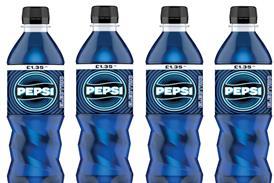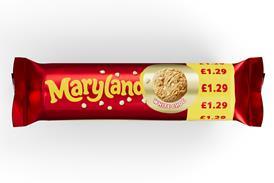Will this be the year c-stores finally go electronic?
Anyone who worries that the machines are finally taking over the Earth can
rest assured that when all our technology grinds to a halt, the local convenience store will almost certainly still be trading.
In truth, the convenience industry is split down the middle, with some stores taking advantage of electronic central ordering, stock control and invoicing, while the rest try to figure out how to receive email and wonder if they would ever recover the costs of investing in epos.
For those with their fingers on the pulse, new developments in the pipeline include: motion-activated TV screens which advertise adjacent products; RFID (Radio Frequency ID) interactive units which, when a product is scanned over them, give customers product information, advice on its use and suggestions for additional purchases; and shelf-edge labels on which prices and product information can be updated from behind the scenes.
A true convenience offering must meet the customer's need for speed and standalone kiosks and self-checkout units will get them out of the door faster, although there's a cost: a loss of human contact which might alarm community retailers.
Mobile phone coupon systems are already in place, but marketing to the phone (or even to Sat Nav - Starbucks has its own store locator) is only the start, with payment from handsets soon to follow.
These innovations will soon become familiar high street sights, but it may be some time before the cost of adopting them falls within the independent retailer's budget.
It's in payment that we are likely to see the biggest changes this year. The rollout of cashless 'wave and pay' systems in London continues, with the banks promising thousands of contactless-enabled cards in circulation by the end of 2008. If adopted, they will keep the queues down and reduce the cost of handling cash - but retailers are already worried about what might happen to the card providers' fees once the technology is widespread. A year from now we will know if their fears are justified.
"Contactless payment is a massive opportunity for retailers, and we plan to adopt the technology after the London trial. The national rollout is due to begin this year and the technology can be added to retailers' existing Chip and PIN pads. The speed we adopt it will depend on the rate Visa and Mastercard hand out the cards.
"We're also keeping an eye on electronic shelf-edge labels and near-field communications (NFC), which will allow shoppers to pay for goods with their mobile phone. We'll see electronic shelf-edge labels in the next 12 months to two years, but we won't be jumping on NFC straightaway.
"Next year we will launch mycostcutter - an online retailer portal which will give Costcutter retailers immediate access to their latest invoices, bulletins, email and central price files. We will also continue development of the Costcutter epos system, now established in 320 stores and set to be introduced in a further 150. This coupled with trials of self-service tills and in-store TV will make the CPoS system invaluable to retailers."
"The Londis IT Forum recently visited IBM's technology centre and they showed us the next generation of retail technology. "The LED shelf-edge talkers will definitely be good news for us if they are adopted as whole displays rather than individual labels.
"However, near-field technology has a few glitches which need ironing out - the signal can be blocked by foil wrappers, for example.
"In 2008 we'll see contactless payment coming to c-stores - we're the perfect environment for quick, low-price transactions.
"The terminals will cost about £1,500, so if 20,000 c-stores adopt them that's a lot of money for the card providers, even before they take a fee."
Anyone who worries that the machines are finally taking over the Earth can
rest assured that when all our technology grinds to a halt, the local convenience store will almost certainly still be trading.
In truth, the convenience industry is split down the middle, with some stores taking advantage of electronic central ordering, stock control and invoicing, while the rest try to figure out how to receive email and wonder if they would ever recover the costs of investing in epos.
For those with their fingers on the pulse, new developments in the pipeline include: motion-activated TV screens which advertise adjacent products; RFID (Radio Frequency ID) interactive units which, when a product is scanned over them, give customers product information, advice on its use and suggestions for additional purchases; and shelf-edge labels on which prices and product information can be updated from behind the scenes.
A true convenience offering must meet the customer's need for speed and standalone kiosks and self-checkout units will get them out of the door faster, although there's a cost: a loss of human contact which might alarm community retailers.
Mobile phone coupon systems are already in place, but marketing to the phone (or even to Sat Nav - Starbucks has its own store locator) is only the start, with payment from handsets soon to follow.
These innovations will soon become familiar high street sights, but it may be some time before the cost of adopting them falls within the independent retailer's budget.
It's in payment that we are likely to see the biggest changes this year. The rollout of cashless 'wave and pay' systems in London continues, with the banks promising thousands of contactless-enabled cards in circulation by the end of 2008. If adopted, they will keep the queues down and reduce the cost of handling cash - but retailers are already worried about what might happen to the card providers' fees once the technology is widespread. A year from now we will know if their fears are justified.
Kevin Widdrington, IT Director, Costcutter
"Contactless payment is a massive opportunity for retailers, and we plan to adopt the technology after the London trial. The national rollout is due to begin this year and the technology can be added to retailers' existing Chip and PIN pads. The speed we adopt it will depend on the rate Visa and Mastercard hand out the cards.
"We're also keeping an eye on electronic shelf-edge labels and near-field communications (NFC), which will allow shoppers to pay for goods with their mobile phone. We'll see electronic shelf-edge labels in the next 12 months to two years, but we won't be jumping on NFC straightaway.
"Next year we will launch mycostcutter - an online retailer portal which will give Costcutter retailers immediate access to their latest invoices, bulletins, email and central price files. We will also continue development of the Costcutter epos system, now established in 320 stores and set to be introduced in a further 150. This coupled with trials of self-service tills and in-store TV will make the CPoS system invaluable to retailers."
Steve Bassett, Londis, Weymouth, dorset
"The Londis IT Forum recently visited IBM's technology centre and they showed us the next generation of retail technology. "The LED shelf-edge talkers will definitely be good news for us if they are adopted as whole displays rather than individual labels.
"However, near-field technology has a few glitches which need ironing out - the signal can be blocked by foil wrappers, for example.
"In 2008 we'll see contactless payment coming to c-stores - we're the perfect environment for quick, low-price transactions.
"The terminals will cost about £1,500, so if 20,000 c-stores adopt them that's a lot of money for the card providers, even before they take a fee."

















No comments yet